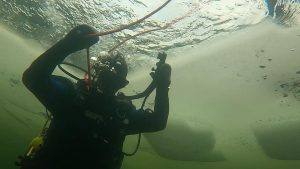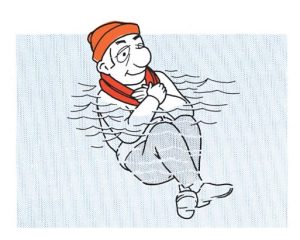Remember that timely notification of an accident is a decisive factor in saving life! Emergency services take care of accidents at sea:
- Phone 115 (emergency service).
- The emergency telephone number of the State Fire and Rescue Service is 112.
Table of Contents
Abandoning the watercraft and ship in an emergency
Below is the information that has been compiled diving instructor and lecturer Valters Preimanis, about Abandoning a Watercraft and Ship in an Emergency Situation and Human Survival at Sea. It has been proven that properly performed regular cold swimming helps people to harden and survive in the cold sea - Human survival in cold water.

Leaving the ship
A ship (yacht or motor yacht) can sink in less than 15 minutes. So there is not much time to prepare an escape plan. That is why timely and careful action planning is very important so that a person is ready for an emergency situation.

Some useful tips to remember when leaving a sinking vessel (yacht or motor yacht):
In practice, the situation is often when the ship does not sink and people left the ship too fast! Prepare the life raft and prepare to step on the life raft only at the last moment! (Lecturer's note)
1. Must be put on as many layers of warm clothing as possible, including those that protect the feet. Make sure your head, face, neck, hands and feet are covered. Button up the clothes, close the zippers, fasten them so that nothing falls out, tie the free ends of the clothes to reduce the ingress of water under the clothes.
2. If a wetsuit is available, it should be worn over warm clothing. (Here it should be remembered that hwetsuit works and warms only on human skin, when put on a sweater it works like a regular rubber suit)
3. If the hydroterp does not have his own flotation device, he must put on a life jacket and fix it correctly. ties must be tightened and all switches must be clamped. (Your wetsuit will most likely not have its own flotation device, unless it is a special rescue suit)
4. If there is sufficient time, everyone should take anti-seasickness medication according to the manufacturer's dosage before entering the lifeboat, or immediately after entering the lifeboat. Seasickness will reduce the chance of survival, as vomiting causes the body to lose a lot of fluid, which is necessary for vital processes. In addition, seasickness promotes hypothermia and weakens the will to survive. (Everyone has to take medicine if there is a lot? Many people who go to sea do not need medicine and taking medicine will waste the medicine)
5. As much as possible, you should try to avoid submersion in the water, for example, you can get into a lifeboat, which is lowered by a crane, or use a rescue system already on the ship's deck. If none of the dry boarding methods are available, use an overboard ladder or descend into the boat by rope or fire hose.
6. As long as possible, avoid entering the water. Attempts should be made to minimize the shock of sudden exposure to cold. Falling into icy water can cause cardiac arrest (It certainly does not threaten healthy people), and uncontrolled acceleration of breathing can end with water entering the lungs.
6.1. Jumping water try to press your elbows to your sides, cover your nose and mouth with one hand, firmly grasping the wrist or elbow of that hand with the other hand. Jumping onto the liferaft cover or jumping into the water at the bow of the liferaft should be avoided if the vessel continues to move forward.
7. When accidentally falling into water or jumping from a ship, one should try to orient himself and determine where the ship is, where the lifeboats, rafts or other floating objects and the other survivors are. If you didn't manage to prepare in advance, button up and fasten your clothes when you get in the water. Cold water can cause severe chills and stabbing or burning pain. These are the body's natural reflexes in an emergency situation that is not immediately dangerous. However, you need to act as soon as possible before you completely lose the use of your hands, button up your clothes, turn on the signal light, find the whistle, etc.
8. While in the water, one should not try to swim, except for those times when swimming is possible to reach a nearby swimming device, another survivor or a floating object to climb on. Unnecessary paddling with arms and legs will displace any warm water between your body and layers of clothing, thus accelerating heat loss. Unnecessary movements of the arms and legs will also cause warm blood to flow from the inside of the body to the arms and legs and the upper layer of the body. This can result in very rapid heat loss. Stay calm and adopt a posture that prevents you from slouching.
9. The position of the body in which the water is taken is very important for the preservation of heat. Try to stay afloat as still as possible with your feet together, elbows at your sides and arms crossed over the front of your life jacket. This condition reduces the surface area of the body that is in contact with the cold water. Try to keep your head and neck above water.

10. Try to get to a lifeboat, raft or other floating object as soon as possible to reduce the time spent in the water. Remember: in water you lose body heat many times faster than in air. Since the effectiveness of your thermal insulation has already been greatly reduced by water-soaking your clothing, you should try to protect yourself from the wind to avoid the wind chill effect. If you manage to get into a lifeboat, you can protect yourself by covering yourself with a cloth, tarp, or an unused piece of clothing. Clinging to other people in the lifeboat or raft will also help keep your body warm.
11. A positive attitude must be maintained without losing hope of survival and salvation. This will improve your chances of prolonging your survival until rescuers arrive. Your will to live can change everything.
12. The arrival of the rescuers!
More about tempering, ice and cold baths
Finally, the information that has been collected diving instructor and lecturer Valters Preimanis, on "Abandoning the watercraft and ship in an emergency". Properly performed, regular cold baths have been proven to help people harden and survive in cold seas.
Cold water shower, hardening benefits
The benefits of a cold bath are why you need to do it
Motivational technique for a cold winter swim
Where to apply for diving training in Latvia?
🤿😀 If you are looking for diving advice or advice on the sport of scuba diving with or without balloons, call a PADI Diver Instructor (PADI diving instructor and lecturer Valters Preimanis) t. 220-77-202 (Whatsapp 220-77-202).

